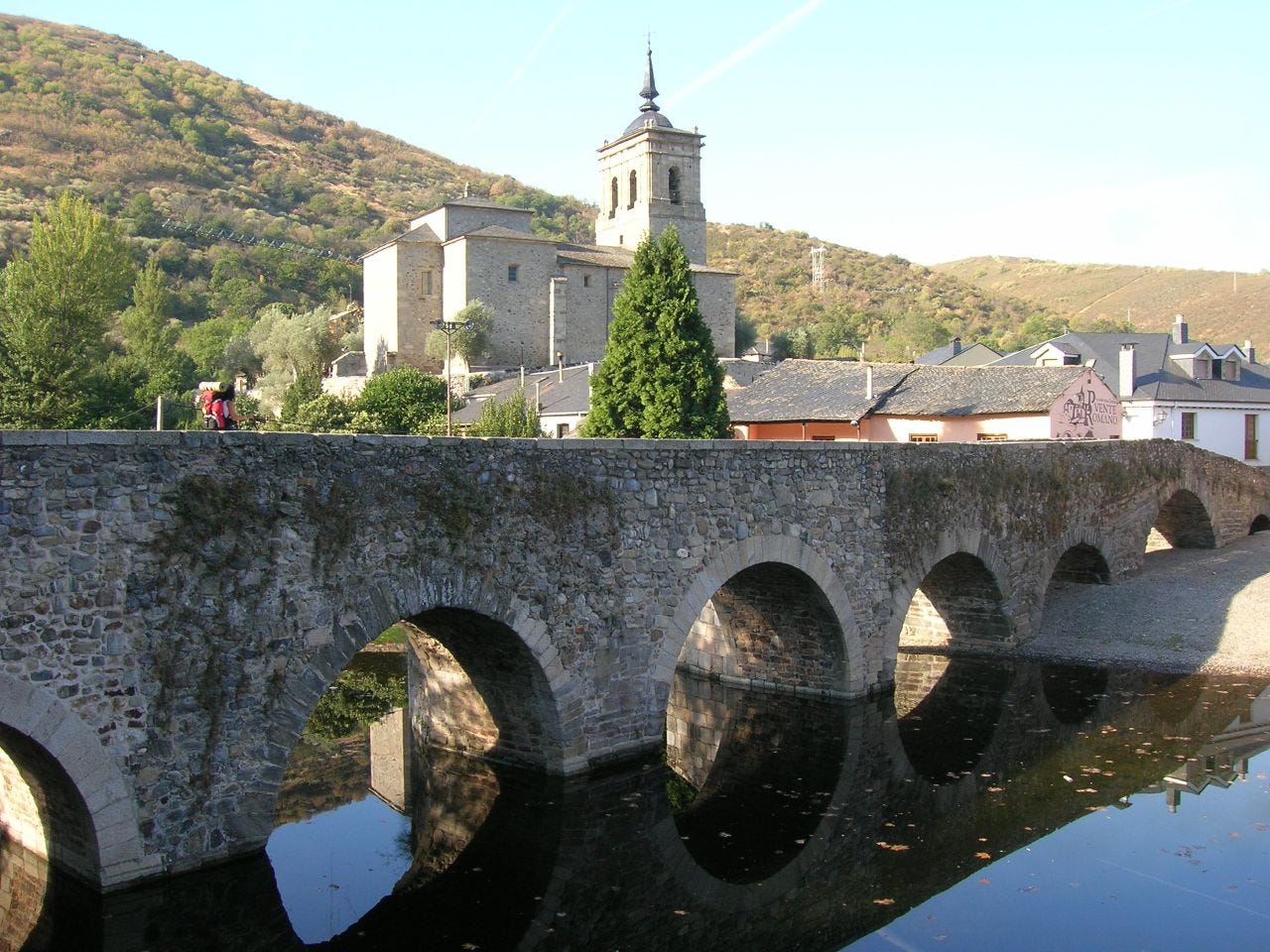The Life of a Modern Pilgrim
Also: A new illustrated edition of “The Hobbit,” the return of Blockbuster, sensitivity readers strike again, and more.

In Harper’s, Lisa Wells writes about Ann Sieben, a modern-day pilgrim, who has walked from Canterbury to Rome and Kiev to Jerusalem. Sieben was born in New Jersey in 1963 and was working as a geological engineer in Europe, “stacking coin and driving a company Jag,” when she decided to walk a leg of the Camino de Santiago:
A few weeks later, she walked the Via Francigena from Canterbury to Rome—less a proper route than a list of towns from the itinerary of a tenth-century archbishop named Sigeric—which she considers her first pilgrimage. Ann started from the cathedral in Canterbury on December 17, 2007, with plans to arrive in Rome for Easter. That meant walking over the Alps in the middle of winter. She had Sigeric’s list and plotted the rest as she went along using “excellent 1:100,000 scale maps” purchased from local bookstores. “Few women had walked it alone, if any at that time,” she later wrote, and people were “generally aghast, often to the point of scolding me like a child for my obvious unawareness—so they thought—of the inherent dangers of a woman alone and in winter.”
Wells met Sieben at a conference in Asheville, where Ann had been invited to talk about her pilgrimages:
Ann introduced herself as a consecrated pilgrim who had renounced worldly possessions. “I travel with no money,” she said, “which means, every night when I get to my destination . . . I ask people for hospitality.” Throughout fifteen years, fifty-six different countries, and more than forty-five thousand miles, she told us, “I have never not found hospitality.”
Ann’s talk wove together some of her greatest hits, subdivided into related “couplets.” A story about two men who leveled rifles at her in the Western Desert of Egypt was paired with one about a crew of men who appeared to be narco-traffickers confronting her with machine guns while she “hoofed it” through the Chihuahuan Desert.
In the first case, Ann was walking across North Africa to Jerusalem, on a pilgrimage dedicated to “J.C. and the Boys.” She was the stranger in that story, the enemy “invader of their peaceful oasis.” She defused the situation by asking the men for water. By expressing an elemental need, she explains, the stranger made herself familiar.
The alleged narco-traffickers confronted her while she walked from Denver to Mexico City. “I am a pilgrim headed to Guadalupe,” she told their ringleader. “My pilgrimage will either end there, at the Basilica, or in Heaven with God. For me, it’s equal. You decide.” In her telling, the men lowered their weapons. Some crossed themselves and wrote down prayers for their grandmothers and children, which Ann promised to deliver to “Our Lady.” In this case, the men were the strangers, and their love of family taught Ann to love, in turn, “thy enemy.”
Every encounter with the stranger is an opportunity to create rapport. Ann’s raison d’être is building trust, because trust is the foundation of peace. Though she walks alone, pilgrimage is paradoxically a social project. “It is personal,” Ann told the crowd. “But it is not private.”
Read the whole thing. And speaking of the Way of St. James, Steven Greydanus reviews a new documentary of the route called Santiago: The Camino Within: “Other than a few low-key dramatized shots illustrating the Gospel account of the call of James and John, the sons of Zebedee, by Jesus, the documentary is constructed of images captured on the pilgrim route, including pilgrim interviews and images of the way and the landscape, from a closeup of lavender flowers to soaring drone shots of rolling golden fields and distant blue hills.”
In other news, Thomas Laqueur reviews Francesca Morgan’s A Nation of Descendants: Politics and the Practice of Genealogy in U.S. History: “Morgan is right that the genealogical imagination is grounded in far more than the desire of individuals to know their past, though it is grounded there as well. And she is right that it is mobilised for political purposes, even if she might decry the recent turn to DNA – the fetishism of the gene – to make these claims. But she is wrong to view the history of genealogical practices largely as a tool in political struggles. Intersectional oppression and its resistance do not need or use its ‘methods and collections’ in the way she claims in a brief coda to each chapter. The real political struggles are about what counts and does not count as the domain in which genealogical practices take place, about who gets a line in the family tree and why. In short, they are about the way kinship – descent – is imagined in the first place.”
George Anders writes about reading the transcripts of his father’s unadmitted testimony at the Nuremberg trials: “Inside the microfilm room in College Park, I suddenly met a very different version of my father. This young man communicated only in German, the native language of his childhood. Everything that he described was incredibly vivid, as if it had happened only days ago. Nazis forcing Jews in his hometown of Liepaja to desecrate their own synagogues. The murder of a cousin on the first day of the Nazi invasion; the shooting of Ed’s grandfather a few weeks later. At war’s end, my dad was the only male survivor in his family. Reaching Nuremberg, he carried the burden of trying to speak for all the relatives whose voices had been forever silenced.”
Sensitivity readers strike again: “Agatha Christie novels reworked to remove potentially offensive language.”
Keep reading with a 7-day free trial
Subscribe to Prufrock to keep reading this post and get 7 days of free access to the full post archives.



